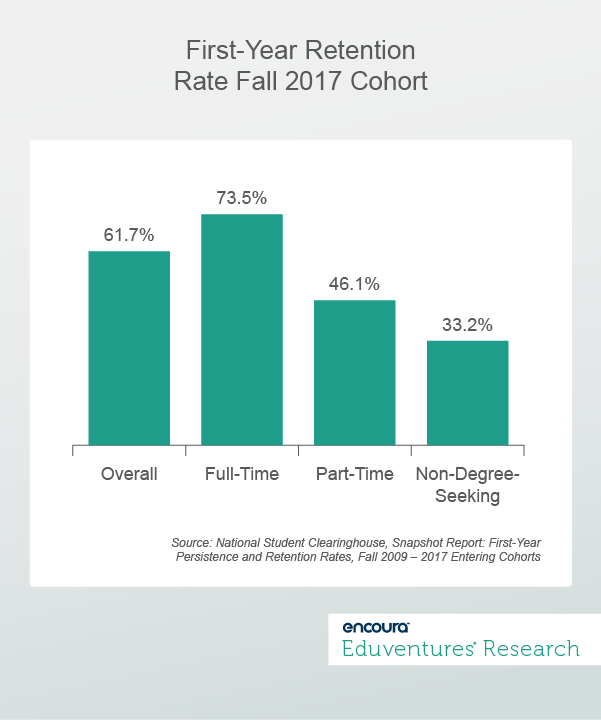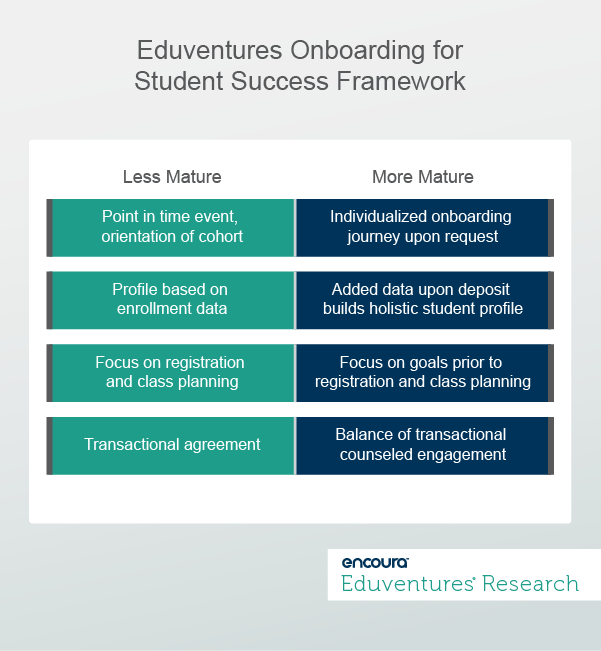How do you know when student onboarding is successful in your institution? Well, they are the ones who enroll next semester, right?
That’s a terrible and ghoulish joke. You should know because you carefully shepherded them through the transition from admissions to enrollment, never losing sight of each and every student. Yet many institutions do lose sight of students and do experience the surprise of attrition.
Why are many institutions so reactive when it comes to retention and student success? At Eduventures, we believe that institutions should take a far more proactive approach. What might that look like?
According to the National Student Clearinghouse, just 74% of all first-time, full-time students are retained into their second year, and this number drops precipitously for part-time and non-degree-seeking student populations (Figure 1).

To combat this outcome, many colleges and universities are embracing the concept of “onboarding” as they transition students from admissions to enrollment. Onboarding, originating in the corporate world, is meant to bring people into your organization in coherent, thoughtful, and organized fashion in order to boost retention and performance. Corporations use onboarding to build employee engagement, train core competencies quickly, and introduce employees to corporate culture with the ultimate goal of increasing employee retention and tenure and to reduce the cost to recruit.
Theoretically, institutions should be able to accomplish similar objectives with students. But
The Orientation-to-Onboarding Spectrum
First, there’s orientation and then there’s onboarding. Consider these two paradigms as two ends of this spectrum. Orientation is “old school;” onboarding is “new school.” Orientation is a one-time, cohort-level program where students are treated the same. When the time is up, the orientation is done whether the goal is accomplished or not.
Onboarding is a continuous, individualized journey that begins upon deposit and ends when the student meets a goal of being successfully integrated into the community.
Of course, it’s not quite as simple as that. Most institutions exist somewhere on a spectrum of maturity from an old-school orientation philosophy to a new-school onboarding philosophy of student transition from admission to enrollment (see Figure 2).
Figure 2.
Less mature organizations get to know their students only by the information in their enrollment profiles, while more mature organizations create more holistic student profiles that update even before the students begin their program. These fuller data profiles, with information about Student Mindsets™, career aspirations, academic competencies, placements, activities, student concerns, etc., help lead coaching and advising conversations right from the start. The students' journeys begin with advisors who have a much more individualized sense of who students are.
Less mature organizations miss the forest for the trees, or in this case, the path for the courses. Students choose their institutions because they have big goals and big dreams. Course registration and class planning are certainly important facets of advising, but good onboarding ensures that student goals lead the conversation with course selection as the logical follow-on to goal-setting, not the other way around.
Finally, less mature organizations focus on “administrivia” to the detriment of deep student engagement. While they may get right down to business and focus on the necessary transactional engagements such as health forms, bill pay, and housing, they can inadvertently push the warm welcome to the side. As they seek to technically connect with students, they can forget to emotionally connect with them. More mature institutions seek ways to bring students into the culture early and often.
To ensure that your institution doesn’t make these mistakes, here are four key questions to ask as you think proactively about your onboarding process:
1. What are your goals for student onboarding?
Onboarding can influence a number of high-priority areas (like academic integration, community building, or working with students at risk) that impact student success. While it’s possible to craft an onboarding strategy that touches many areas at once, it is better yet to create a strategy that focuses on the area that promises the greatest impact. Before you design your onboarding strategy and programs, decide what your highest priority institutional onboarding goals are and stay true to those.
2. Who is involved in student onboarding?
Administrators who enroll and initially orient students—those who work in student or academic affairs, and, of course, faculty—all play an important role in onboarding new students. The organizational leadership and accountability structure of onboarding efforts will determine its eventual success. At the same time, the judicious use of human resources is important. You must involve the right people at the right time.
3. How will you use data and technology to catalyze onboarding?
Technology systems, like constituent relationship management (CRM) solutions, can support your efforts to manage student transitions. The most important step you can make in using data and technology to catalyze onboarding is to ensure that you leverage what you have learned about students during the admissions process to help them settle into college life. Many institutions have a wall between admissions and enrollment, where the information obtained as part of the recruitment process never makes it to the advisors who are helping to onboard students. Technology can be used to tear down this wall.
4. How will you know when students are successfully onboarded?
What does a successfully onboarded student look like at your institution? Describe student benchmarks in detail: academic engagement, community engagement, financial security, mental health, etc. These are the metrics by which you can measure the success of your onboarding work.
How long do you imagine onboarding will last for most students? As an example, for traditional-aged freshmen, we could imagine checking against benchmarks at six weeks, the end of the first semester, the end of the first year, and upon entry into the second year. If students meet all of their benchmarks at any of these intervals, they have been onboarded successfully (if your onboarding goals are well chosen).
Finally, and most crucially, what are your action plans for students who fall outside the benchmarks?
The Bottom Line
It’s a big ask to know where every student stands. But this proactive approach to student success could see small problems long before they grow into critical issues for students and eventually into enrollment issues for your institution. We’ll leave you with this question, what if institutions turned the retention problem around asking not about how to retain students, but how to integrate students? Perhaps onboarding as an approach to student success could accomplish this.
Eduventures Principal Analyst at ACT | NRCCUA
Contact
Join us in Boston, June 3-5, 2020, as we convene eminent thinkers, leaders, and practitioners from across the higher education spectrum to examine and showcase the best ideas, old and new. If there is one event in higher ed you attend in 2020, make it Eduventures Summit.


